In the audio world, a mixer is one piece of gear we often cannot do without—especially in live sound re-enforcement. As the name suggests, a mixer is a processor or the central hub where different audio signals are combined and mixed.
Although we have digital and analogue mixing consoles, digital mixers are gradually gaining ground over their analogue counterparts.
A digital mixer takes the analogue signal from audio sources like microphones, synthesizers, line instruments, and other audio sources and then converts those signals to digital signals.
Analogue signals are only sometimes as clean as digital signals. Analogue signals often come with unwanted noises, which are detrimental to audio. Digital signals are much cleaner and can always be better enhanced by applying effects from the digital mixer.
Although analogue mixers will always have their unique place and unique advantages in the world of audio, digital mixers, on the other hand, have advantages that also make them quite irresistible.
It is generally agreed that digital mixers offer much more flexibility in audio mixing—both on stage and in the studio. For example, you can save and create custom mixes for different musicians.
These mixes can be recalled at any point they are needed. All you have to do is press a key. Also, you have many presets and effects to play around with in different scenarios. Covering the entire advantages of digital mixers might be beyond the scope of this article.
However, with their advantages, they also come with a huge financial and technical price. Financially, digital mixers are a lot more expensive; technically, the learning curve is a lot steeper.
However, this doesn’t reduce its awesomeness or usefulness in audio. This article will discuss some of the best digital mixes for audio and mixing scenarios.
It doesn’t matter if you are searching for a digital mixer for live sound, a small church, a studio, etc.; there is something for you. All you have to do is, read on!
Table of Contents
5 Best Digital Mixers for Live Sound
5 Best Digital Mixers for Recording Studios
5 Best Digital Mixers for Church
5 Best Digital Mixers for Karaoke
Review of 5 Best Digital Mixers for Live Sound
Digital mixers are essential in live sound for their versatility, control over audio signals, routing options, built-in effects, and recallable presets.
They simplify the mixing and processing of multiple instruments and vocals from a single console, ensuring clear and enjoyable output for the audience through the PA system.
Allen & Heath Qu 24/32
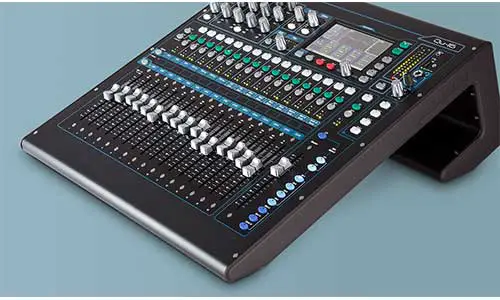
The Allen & Heath Qu 24/32 digital mixers are popular choices for live sound applications. With 24 or 32 analogue inputs, these mixers can handle a variety of instruments and microphones.
They provide extensive processing options, including built-in effects, EQ, compression, and delay.
| Pros | Cons |
| High-quality effects and processing options (EQ, compression, reverb, etc.) | It may be overwhelming for beginners. |
| User-friendly touchscreen interface | Many of the functionalities in the mixer are hidden or may need to be easier to find or navigate. |
| Remote control and multitrack recording capabilities via a computer or iPad | The touch is not as smooth as the phones and tablets that you may be used to |
| Compact size and sturdy build quality make them suitable for small to medium-sized venues, bands, and events | Requires manual diving to understand the mixer and its workflow |
| Comprehensive scene management system, enabling you to save and recall complex mix settings effortlessly. | Limited inputs compared to larger consoles |
| Allen & Heath’s proprietary dSNAKE protocol allows for easy expansion and connection of remote AudioRacks, extending the input/output capabilities. |
PreSonus StudioLive 32SC
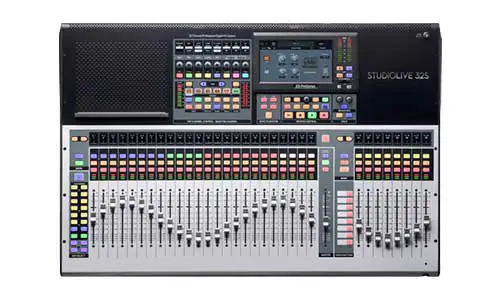
The PreSonus StudioLive 32SC excels in live sound scenarios due to its powerful processing capabilities, intuitive interface, and extensive connectivity options.
Its 32 input channels and 16 mix outputs provide ample flexibility for bands, events, and venues, ensuring every sound can be captured and fine-tuned.
Seamless integration with other StudioLive Series III mixers and stage boxes enhances system expandability and versatility.
| Pros | Cons |
| Intuitive user interface | Less impressive FX plug-ins |
| Clear 17″ touchscreen simplifies navigation | Some people may find it challenging to navigate and operate at first, particularly, those that are new to digital mixers |
| Integration with Studio One DAW | It does not come with built-in Dante support |
| Internal effects | Offers only eight DCA (Digitally Controlled Amplifier) groups |
| Multiple matrix mix routing options | Occasional issues with firmware and software updates have been reported |
| Streamlined mixing/recording due to the UC Surface Control and Capture live recording software |
Zoom LiveTrak L-20
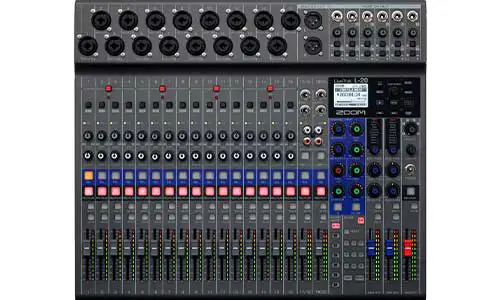
The Zoom LiveTrak L-20 is a versatile digital console designed for comprehensive audio mixing, monitoring, and recording. It offers 20 discrete audio channels for complex productions, thus enabling live sound handling with great precision.
It features 16 mono channels with high-gain, low-noise mic preamps, and four additional stereo channels. The L-20 also provides six custom monitor mixes, 3-band EQ, 20 built-in effects, and a 24-bit/96kHz 22-track recorder, ensuring high-quality output.
| Pros | Cons |
| The innovative combination of USB audio interface, digital mixer, and multitrack recorder. | Limited to small-scale live setups, as it cannot have more than 20 inputs. |
| Effective for small-scale live-sound duties. | Software/DAW integration on the device may be difficult |
| It provides wireless management via a complimentary iOS application, from which you can manage and access Library and Scene library directly | Weak customer support services, in case you face any damage or technical difficulties |
| Useful for tracking sessions and computer mixing | |
| Includes 20 built-in effects | |
| Equipped with quiet and advanced preamps | |
| Can capture pristine audio in resolutions up to 24-bit/96 kHz | |
| Compact design |
Behringer X AIR XR18
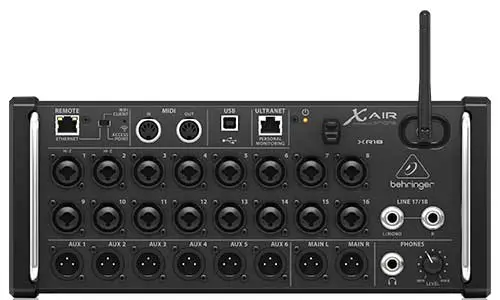
The Behringer X AIR XR18 is a compact, robust unit perfect for live sound applications. It features 18 inputs, including 16 Midas-designed mic/line inputs and two line inputs, known for their audio reproduction quality.
It also provides eight outputs (main L/R and six auxiliaries). This digital mixer can be controlled via iPad/Android tablets, highlighting its flexible and modern approach to sound management.
Furthermore, the XR18 offers an 18×18 USB audio/MIDI interface and supports 2-track stereo recording, making it suitable for mobile recording and live performances to be multitracked for later mixing.
| Pros | Cons |
| Compact and sturdy design | Limited to only small-scale live setups, as it has fewer channels compared to some competitors |
| One headphone output | No hands-on experience can be a struggle when working with bands |
| Integrated Wi-Fi module | Poor Wi-Fi range |
| Multi-channel USB audio interface | The absence of physical faders might be a disadvantage |
| Programmable Midas preamps | Preamps may not sound as good as those on some competing models |
| 100-band Real Time Analyzer | It needs an external router for reliable wireless performance |
| Ultranet, Ethernet, and MIDI connections | |
| Rack-mountable design with easy-to-grasp handles | |
| Portability with impressive performance | |
| Hi-Z inputs, suitable for guitars |
YAMAHA TF1
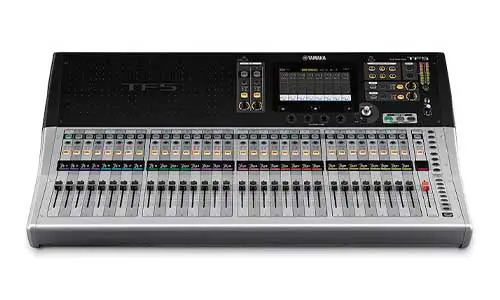
The Yamaha TF1 is a compact digital mixer designed for live sound applications. It features TouchFlow Operation™, which provides an intuitive and user-friendly interface for quick and efficient control.
The mixer includes recallable D-PRE™ preamplifiers, ensuring high-quality microphone amplification. With 40 input mixing channels, 20 aux buses, and 8 DCA groups, the TF1 offers impressive capability and versatility for smaller live sound setups.
| Pros | Cons |
| Entry-level digital mixer for live sound applications | Potentially limited scalability for larger live sound setups due to the number of inputs |
| Easy transition from analogue mixers | Some customers have complained about its flashing tap button, which they found distracting |
| Generous I/O with assignable outputs | Small touchscreen |
| Intuitive touchscreen interface | No matrixes and delays in outputs |
| High-quality parts and materials |
Review of 5 Best Digital Mixers for Recording Studios
Digital mixers offer higher channel count and routing flexibility, making managing complex recording setups, like recording orchestras, acapella groups, and bands, easier.
It also helps the live streaming and mixing of these performances on IG Live, YouTube Live, Twitch, etc. They provide live digital signal processing for effects, equalization, and dynamics.
Their integration with Digital Audio Workstations also aids in session recall and automation. Lastly, compared to equivalent analogue mixers, their compact size makes them more space-efficient, an important consideration in many studios.
Behringer X32 Producer
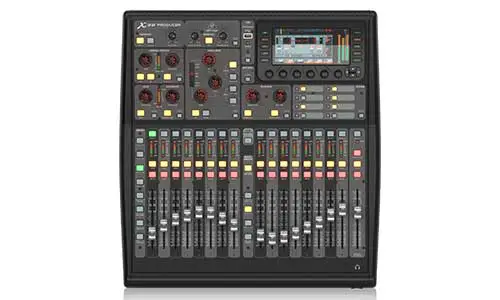
With its 40-input and 25-bus configuration, the X32 Producer provides ample connectivity options for recording multiple audio sources simultaneously.
It features 16 programmable MIDAS preamps, known for their high-quality sound reproduction, ensuring pristine audio capture in the studio environment. Its very intuitive interface and motorized faders make it easy to adjust and automate settings during the recording process.
Furthermore, it is designed to integrate seamlessly with other X32 consoles, the S16 digital stage box, and the P-16 personal monitoring system, providing a complete studio solution.
| Pros | Cons |
| Supports uncompressed recordings via USB connection | Some users have reported that the preamps and converters of the Behringer X32 Producer may not match the quality of more expensive alternatives |
| A comprehensive set of built-in effects and signal-processing tools | The user interface and workflow may take some time to get used to for some producers |
| Allows for the storage of show presets, making it easy to recall settings for different projects | Some customers have reported concerns about the durability and build quality of the product |
| Regular system updates ensure the console is working at its maximum capacity | Limited preamp and converter quality |
| Smaller and more portable compared to the larger studio console | |
| User-friendly layout and intuitive controls allow for easier navigation and control over various parameters | |
| Offers remote control options via the free iPad app or Ethernet-connected editing and control software |
Soundcraft Ui24R
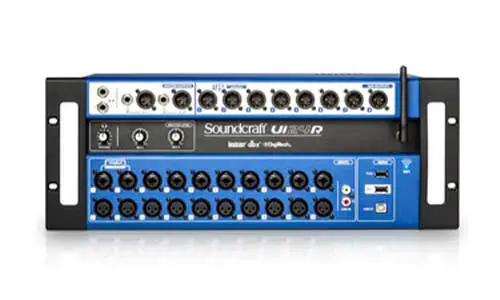
The Soundcraft Ui24R is a versatile and powerful rack-mountable digital mixer designed for both live sound and studio applications.
It offers flexible I/O options, pristine sound quality, intuitive wireless control, and reliable performance in a streamlined and compact design.
With 24 channels, including ten combos 1/4”-TRS/XLR inputs, 10 XLR inputs, two line-level inputs, and two channels of digital USB playback, the Ui24R provides comprehensive connectivity for mixing from multiple sources.
| Pros | Cons |
| It can be controlled remotely using smart devices | Lack of physical control surface may be less desirable for some users |
| The mixer also functions as a stage box, a multitrack recorder, and a USB audio interface | A limited number of built-in effects |
| Intuitive and user-friendly interface, requiring minimal manual diving for operation | Reliance on smart devices for control may introduce potential compatibility issues or dependency on battery life or connectivity |
| Streamlined and compact rack-mountable design, saving space in the studio setup. |
Keith McMillen K-Mix
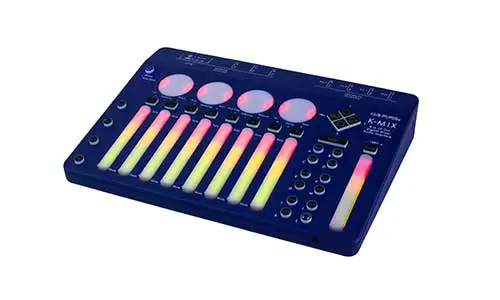
The Keith McMillen K-Mix is a versatile and innovative tool for recording studios, especially for smaller setups and bedroom producers. Combining a mixer, audio interface, and MIDI controller in a compact unit offers a range of capabilities.
The K-Mix provides flexible routing options, per-channel DSP, and MIDI communication, making it suitable for controlling various DAWs and external MIDI hardware.
| Pros | Cons |
| Features touch-sensitive controls with LED backlighting, thereby eliminating the need for delicate moving parts | Its compact size may limit the number of inputs and outputs compared to larger mixing consoles |
| With its sturdy construction, it can withstand the demands of both studio and live environments | Eight inputs and three auxiliaries may be limiting for some of you. Due to that, it may not be able to record bands or even drums |
| The K-Mix includes surround-sound processing modes for enhanced spatial audio capabilities | Suitable only for bedroom setups and may not be suited for larger scale recordings. |
| Quite affordable when compared to other digital mixers in the market | |
| Allows for the manipulation and adjustment of audio elements in a quadraphonic (4-channel), 5.1 surround, 7.1 surround, and Octo (8-channel) audio setups |
Mackie DL32S
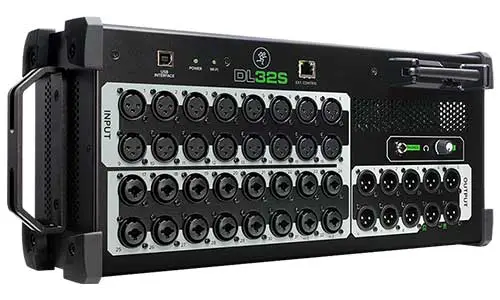
The DL32S offers 32 channels for precise and transparent audio capture. It integrates seamlessly with popular DAWs, thereby enabling efficient multitrack recording and playback.
The mixer also supports wireless control through the Mackie Master Fader app, allowing engineers to make adjustments from anywhere in the studio.
| Pros | Cons |
| Robust build quality | May be larger and heavier compared to more portable or compact mixers |
| Features Onyx+ mic preamps that deliver clear and accurate sound reproduction | Limited scalability and expandability for larger setups |
| It can be controlled wirelessly via the Mackie Master Fader app | It relies on built-in Wi-Fi for control and operation |
| It offers 32 input channels and ten fully assignable outputs, providing ample options for routing and connectivity. | Offers a limited number of aux sends (eight) |
| Built-in Wi-Fi for easy connection and control | It lacks tactile experience as it does not feature physical faders, and relies solely on touchscreen control |
Allen&Heath SQ5
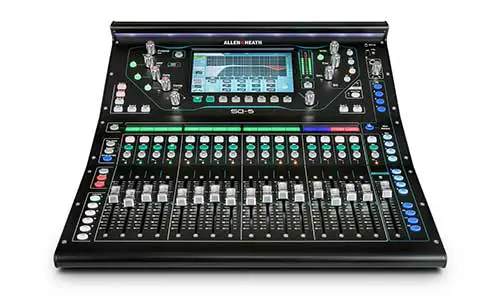
The Allen & Heath SQ-5 is a high-performance console designed for demanding studio recording applications. It is powered by the revolutionary XCVI 96kHz FPGA engine, allowing ultra-low latency (<0.7ms) and superior audio fidelity.
With its 48 processing channels and 96kHz mix core, it’s considered the most powerful in its class, despite its compact physical format. That makes it suitable for professionals handling live sound, recording, and streaming applications.
| Pros | Cons |
| Adaptable for various scenarios, from recording/mixing studio setups to podcast studios to live venues. | The digital interface may be complex for beginners |
| Its advanced routing lets you direct audio between channels, outputs, and groups for optimized band recordings. That helps with recording multiple drum mics, guitars, bass, etc., which could be complicated otherwise. | Limited physical controls compared to larger consolesIt could also be used for live streaming or digital concertsIt may require additional hardware for more complex setupsOffers a range of accessories like a tablet shelf, rack mounting kit, and dust coversIt may require additional time to learn all functionalitiesPotentially less community support and resources than other well-known brandsCompatibility issues with certain software or hardware |
Review of 5 Best Digital Mixers for Church
Church sound differs from other live sound settings due to the distinct acoustics of churches, characterized by high ceilings, large open spaces, and hard surfaces. Longer reverberation times can affect sound clarity.
Further, church sound systems prioritize speech reinforcement, ensuring clear and intelligible sermons and prayers. Balancing sound amplification while preserving natural acoustics is crucial.
With digital mixers, churches can enjoy built-in effects (such as EQ, compression, noise gates, delay, and reverb), a user-friendly interface for volunteers, compatibility with various consoles, in-ear monitoring, digital snakes, etc., providing a comprehensive audio ecosystem.
Yamaha TF5 32-Channel Digital Mixer
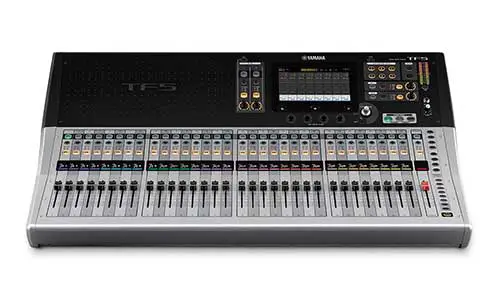
With robust and versatile features, the TF5 provides an ideal solution for churches, managing everything from choir performances to sermons.
Its functionality, user-friendliness, and professional sound quality make it a prime choice for churches seeking a reliable, high-performing audio mixer.
Overall, it is designed to handle complex audio setups easily, delivering crisp, clear sound quality with its 48 input mixing channels, 33 motorized faders, and 20 AUX buses.
| Pros | Cons |
| It generously provides 16 assignable outputs and up to 32 local inputs for flexible audio routing | Some users may find the TF5 challenging due to its many features. |
| Its 33 motorized faders increase precision in sound adjustments. | Despite its intuitive design, there could still be a learning curve, especially for volunteers with little sound engineering experience |
| Having a high fader count, the mixer has reduced sound glitches, improving the overall sound quality. | The TF5 may be expensive for some smaller churches |
| Using a TouchFlow operation, the intuitive feature simplifies audio mixing, even for beginners. | Its large size might be an issue for churches with limited space |
| The mixer is handy for quicker sound setups, featuring plenty of presets, which is especially beneficial in churches where volunteers run the sound system. | Some customers have reported a slow response time on the console. |
| Its USB recording and playback enable recording sermons or performances for later use | The user guide lacks detailing and may not cover all tips and tricks for optimal usage |
| Built-in 1-knob compression/EQ for easy sound tweaking |
Allen & Heath SQ-7
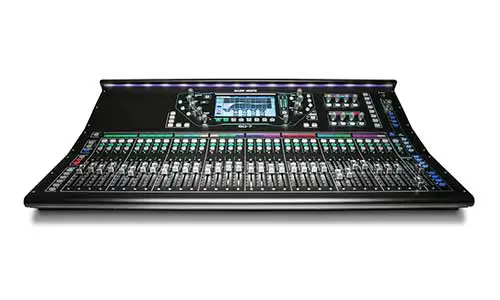
The Allen & Heath SQ-7 features a 48-channel configuration with 32+1 motorized faders and 32 high-quality microphone preamps, making it well-suited for houses of worship. The SQ-7 utilizes Allen & Heath’s XCVI 96kHz FPGA engine, delivering exceptional audio fidelity.
With its extensive live sound mixing capabilities and pristine high-resolution audio quality, the SQ-7 excels in demanding scenarios such as church services, providing clear and immersive sound reproduction.
| Pros | Cons |
| Fast startup compared to other digital consoles | Initial investment cost may be higher compared to analogue alternatives |
| Ultra-low latency of <0.7ms for seamless performance | Requires sufficient understanding and knowledge to utilize all the features effectively |
| Built-in LCD, scribble strips, and buttons for convenient operation | Upgrading from an analogue mixer may require adjustments and learning |
| An ample number of channels are available | May have more channels than necessary for smaller church setups |
| Daylight-readable display for outdoor events | Maintenance and technical support may be required for optimal performance |
QSC Touchmix-16
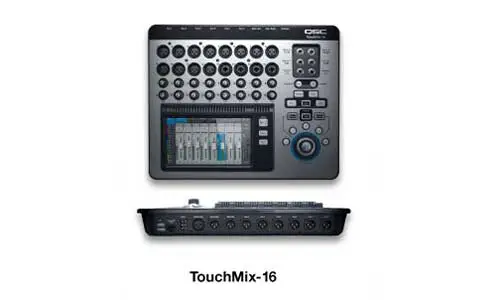
With a combination of touchscreen and hardware controls, the TouchMix mixers offer fast and intuitive operation. They boast excellent sound quality and can record and playback directly from a USB hard drive.
| Pros | Cons |
| Built-in WiFi for remote control and device syncing | A limited number of built-in effects (although customizable) |
| Features 16 mixing channels, professional-grade audio processing, and advanced connectivity options | It may require additional external control devices for some setups |
| Compact size and portability | Firmware updates may be necessary for accessing new features |
| Wide range of room and instrument presets | Some users may prefer physical faders for mixing |
| Class-A mic preamps | Its smaller size may limit connectivity options for larger setups |
| Good quality & intuitive touchscreen | It may require additional investment in external storage for recording |
| Customizable effects and aux return controls |
Midas M32
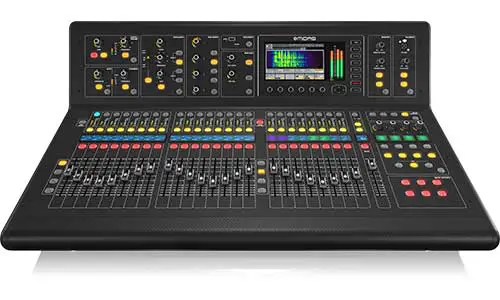
The Midas M32 digital console is highly regarded and well-suited for church applications. Its 32 Midas microphone preamplifiers, 25 Mix buses, and 40 Input channels offer professional-quality sound.
Its routing options allow multi-track recording and computer connection via USB or Dante.
| Pros | Cons |
| Analogue-modelled compressors and EQs give you high-quality processing | It could be considered expensive |
| Award-winning and high-quality PRO Series microphone preamps | Relatively heavy |
| Easier workflow due to USB recording functionality | Faders and controls may require adjustment for individual preferences |
| Robust and solid construction with high-quality knobs | The screen placement and adjustment options may not suit everyone |
| Ample input channels and mix buses are available | Limited availability of detailed specifications |
| Versatile effects and plugin options | Size and dimensions may not be suitable for all setups |
Behringer WING
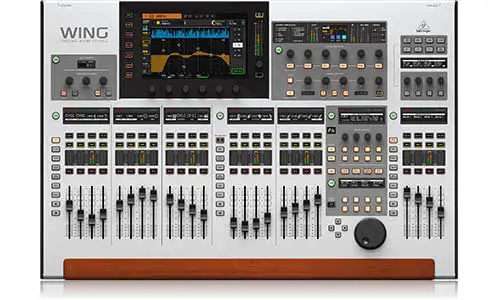
The Behringer WING is a versatile digital mixing console suitable for church sound applications. It offers ample routing options with 48 channels, four main outputs, eight matrix outputs, and 16 aux stereo buses.
The large capacitive touchscreen interface and touch-sensitive rotary controls enhance ease of operation.
| Pros | Cons |
| Flexibility in mixing sources rather than just inputs, providing enhanced control | Advanced features and touchscreen interface may require some time to understand and utilize effectively and fully |
| Consideration for audio input and output flexibility, with AES50-enabled stage box options | Some customers have expressed concerns about the long-term durability of Behringer products, including the WING |
| Easy routing capabilities, making it suitable for church audio technicians | Limited availability of comprehensive documentation or support resources specifically tailored to church-sound applications may make it difficult to use |
| Intuitive touchscreen interface with touch-sensitive rotary controls for ease of operation | |
| Customizable fader sections and custom controls for tailoring the console to specific requirements |
Review of 5 Best Digital Mixers for Karaoke
Digital mixers allow you to adjust volume levels, EQ, and effects to achieve a well-balanced sound of your vocals, which is suitable for live Karaoke. They can accommodate multiple singers with multiple customized microphone inputs.
These mixers often come with other built-in effects processors, enhancing vocals with reverb, delay, or other effects.
Lastly, digital mixers can provide playback and recording options, allowing you to easily record karaoke sessions and play them back for practice or performance evaluation.
Alesis Multimix 4 USB FX
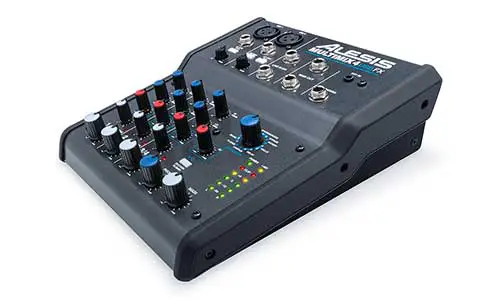
The Alesis Multimix 4 USB FX is a four-channel desktop mixer that offers versatile functionality for karaoke enthusiasts. This compact mixer allows you to mix live audio, record directly to a computer, and use your computer as a karaoke player.
With features like mic-, line-, and guitar-level inputs, 2-band EQs on all channels, and +48V phantom power for XLR inputs, it provides flexibility and control over the audio signal.
| Pros | Cons |
| It offers USB connectivity and a USB audio interface for recording and playback, enabling seamless integration with digital audio workstations | Lack of RCA stereo inputs |
| Compact size and effects processing capabilities make home studios, singers/rappers, and bedroom producers convenient. | Limited to recording at a sample rate of up to 48 kHz |
| Features 16 onboard effects for added versatility | |
| Provides volume, pan, and EQ controls for quick adjustments to the mix | |
| Integrated multicolour LED meter for visual monitoring of the main output level | |
| Offers an impressive selection of 20 high-quality guitars, amps, and effect models |
Voco Pro DA-1000 Professional
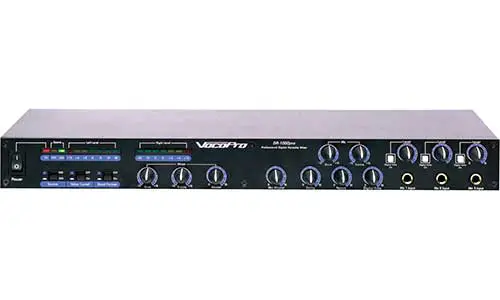
The Voco Pro DA-1000 Professional allows you to control and adjust audio parameters such as volume, tone, and echo effects, ensuring optimal vocal performance. It offers multiple microphone inputs, allowing multiple singers to participate simultaneously.
| Pros | Cons |
| It offers various connectivity options, including RCA and XLR inputs, making it compatible with a wide range of audio sources | A limited number of inputs compared to larger mixers |
| Built-in digital key control for pitch adjustment | Basic design and may lack advanced features found in higher-end mixers |
| Durable construction for long-lasting performance | Lacks more extensive effects options |
| Expensive, given the functionalities it offers |
Mackie DL-1608
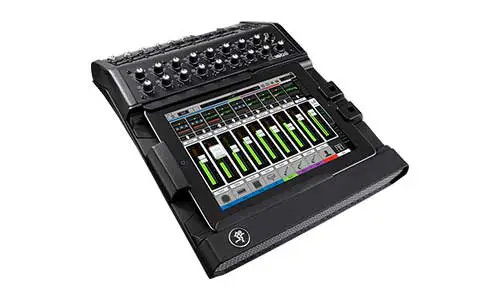
The Mackie DL-1608 features an intuitive interface and powerful features that offer convenient and professional audio mixing for karaoke setups. It comprises 16 Onyx mic preamps and eight balanced outputs, providing ample connectivity for microphones and speakers.
Its integrated iPad control allows for wireless mixing, making it easy to control the device around the venue.
| Pros | Cons |
| Includes built-in effects processors, allowing you to enhance the karaoke experience with reverbs, delays, and other effects | Plastic chassis and the external power supply may affect durability and portability |
| Affordable and cost-effective solution | The circuitry can run warm, potentially affecting long-term performance |
| Intuitive and well-designed GUI on the iPad app for easy and fast operation | Limited functionality for experienced professionals compared to higher-end mixers |
| Suitable for semi-pro users and popular among bands that mix themselves | iPad playback and recording can only occur when the iPad is docked |
Roland GO
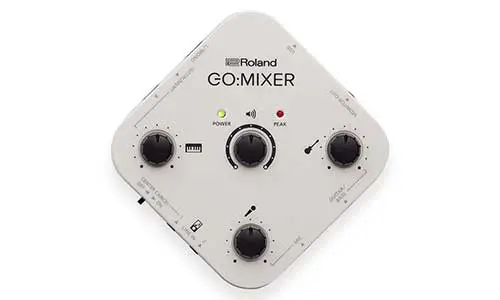
Roland GO: Mixer is a compact and portable digital mixer that offers a convenient solution for recording and mixing audio by using a smartphone or a tablet.
So whether you want to play an instrument or record vocals, these device has up to eight audio inputs for those applications.
| Pros | Cons |
| Compatible with smartphones for convenient recording and sharing. | Limited audio input sources and lack of advanced features & functionalities compared to larger mixers |
| Offers a range of audio input options, including microphones, guitars, and keyboards. | Some customers have reported issues with battery life and durability |
| Includes an onboard 8-track recorder for storing songs. | It may offer limited control and customization options |
| Batteries can power it for on-the-go use | Not ideal for complex audio mixing tasks |
| Convenient and hassle-free solution for cover artists and content creators | |
| Beginner-friendly |
Sound Town Wireless
- VERSATILE COMPATIBILITY: The SWM15-PROS‘ multiple input / output connectors including HD Audio Return Channel, 3.5mm and optical combo output enables it to be compatible with a variety of devices including smart TVs (HDMI ARC needed), home receivers, soundbars and etc.
- HD Audio Return Channel FUNCTION: Please check the pictures for CEC/PCM setting guidance. Please help make sure to enable your TV’s CEC and choose PCM as audio format under expert setting on the TV. The HD Audio Return Channel on the SWM15-PROS karaoke mixer allows you to extract the audio from the TV to the mixer. This allows the mixer to blend the music and vocal, and send the mixed signals to a soundbar or amplifier (HDMI cable is not included)
- AUX/OPTICAL COMBO: The Audio Out port can be served as either an AUX (3.5mm Jack) or Optical output (with the included AUX to Optical adapter). It supports a variety of sound bars like Bose 300/500/700, Samsung, Vizio, etc.
- EASY-TO-SETUP: With up to 16 selectable frequencies and independent volume controls, the karaoke mixer system supports up to 2 wireless mics or 2 wired mics (not included) and its operation range is up to 100 feet line-of-sight
Sound Town Wireless is a cutting-edge karaoke system that offers a seamless and immersive singing experience. It utilizes advanced wireless technology, allowing you to move freely while singing your favourite songs.
| Pros | Cons |
| Includes a high-quality microphone with crystal-clear audio transmission, eliminating the need for cumbersome cables | It may require an initial setup and connection process |
| A vast library of songs with various genres and languages | Wireless connectivity range may be limited |
| User-friendly interface for easy navigation | Reliance on battery power, requiring occasional charging |
| Customizable audio settings for optimal sound quality | Potential interference from other wireless devices in the vicinity |
| Suitable for both home and party use | Some of you may prefer a wired connection for stability and reliability |
| Affordable |
Difference Between Digital and Analogue Mixers
Both digital and analogue mixers perform the same essential function: controlling and modifying audio signals. However, the way they process those signals and the functionality they offer varies greatly.
Analogue mixers handle audio signals in their natural, continuous form. Their operations are inherently hands-on and tangible, as most modifications require physical adjustments to knobs and sliders.
Analogue mixers offer a warmer, more organic sound, which is favoured in certain music genres. However, they may need more flexibility and control than their digital counterparts.
Digital mixers, on the other hand, convert audio signals into digital, non-continuous sequences of numerical data. That enables a plethora of processing options and additional features.
Each channel on a digital mixer can be equipped with comprehensive equalization, compression, and gating tools. Moreover, digital mixers allow for extensive customizability, storage of settings, and precise reproducibility of mixes.
Despite these advantages, digital mixers are typically more expensive than analogue mixers. That is due to the more complex technology and additional capabilities of digital mixers.
Yet, the price disparity between the two is decreasing as digital technology evolves and becomes more affordable.
Secondly, digital mixers lack the warmth and natural tone of analogue mixers. Lastly, some mixers combine the best of both worlds by combining analogue inputs/outputs with digital signal processing.
Are Digital Mixers Better than Analogue Mixers?
Digital mixers are better than analogue mixers if you value adaptability, versatility, and functionality. However, analogue mixers may be better if you prefer workflow simplicity and a warmer and more natural sonic characteristic.
Digital mixers allow extensive processing, customization, and recallable settings for every channel. That includes a broad range of equalization, dynamics, effects, and routing options. They can accommodate a higher number of inputs and outputs due to their digital infrastructure.
However, they’re generally more expensive, and some users may find them more complex. In contrast, analogue mixers are often simpler and more intuitive, providing a quick, hands-on mixing experience.
They process signals rapidly with tactile control through knobs and sliders. That makes them preferable for situations requiring a fast workflow. Although they lack some of the digital mixers’ capabilities, many people appreciate analogue mixers’ unique, warm sound character.
Pros and Cons of Digital Mixers
Pros of Digital Mixers
- Enhanced Functionality
Digital mixers often provide more processing options and features than analogue mixers, including precise equalization, compression, reverb, and other built-in effects, allowing you to shape your sound more intricately.
- Automated Features and Remote Control
These devices offer automated functions, such as motorized faders that automatically adjust to preset levels. Also, remote control options allow engineers to adjust levels from different parts of a venue via a tablet or laptop.
- Save and Recall Settings
With a digital mixer, you can save your settings for each channel, making it easier to recreate the same mix later or maintain consistency across different venues. That is particularly beneficial for touring bands or recurring events.
- Greater Input/Output Capacity
Due to their digital nature, these mixers can handle more inputs and outputs, making them a more fitting choice for large, complex setups.
- Compact and Lightweight
Despite their extensive capabilities, digital mixers are usually more compact and lightweight than their analogue counterparts, making them easier to transport and set up.
Cons of Digital Mixers
- Higher Cost
Digital mixers are typically more expensive than analogue mixers due to their more complex technology and extensive capabilities.
- Learning Curve
They can be more complex to operate, particularly for those used to analogue mixers. The numerous features and settings can be overwhelming for beginners.
- Potential for Latency
Digital processing can lead to latency, a minor delay from when an input signal enters the mixer to when it exits the speakers.
- Dependence on Electricity
These devices rely entirely on electricity and often require a stable power supply to function optimally. Power fluctuations or failures can lead to interruptions or loss of settings.
- Potential Sound Quality Debate
While digital mixers offer crystal clear audio, some professionals argue that analogue mixers provide a warmer, more natural sound.
Maintenance Tips for Digital Mixers
- Dust and grime can affect the performance of a mixer over time, so it is important to clean the mixer and its components regularly. That includes wiping down surfaces with a soft cloth and avoiding harsh chemicals, especially on touchscreens.
- If your mixer has moving parts, it’s essential to ensure they are adequately lubricated to prevent wear and tear. Regular lubrication checks can greatly extend the lifespan of your mixer.
- Keep your digital mixer’s software up-to-date. Manufacturers often release updates that fix bugs, improve performance, and add new features.
- Store and use the mixer in dry and stable conditions, as electronic equipment can be sensitive to environmental factors such as moisture and extreme temperatures.
- Back up the settings, scenes, and presets regularly to save time and ensure consistent sound quality across different sessions.
Conclusion
In conclusion, various digital mixers are available on the market, each suited to a specific environment and purpose. The Allen & Heath Qu 24/32 and PreSonus StudioLive 32SC are standout options for live sound performances due to their flexibility and hands-on control, which is great for live mixing.
Regarding recording studios, the Behringer X32 Producer and Soundcraft Ui24R have proven to be top-notch in handling studio needs. Churches often find great utility in mixers like the Yamaha TF5 32-Channel Digital Mixer and the Allen & Heath SQ-7.
In contrast, karaoke enthusiasts might find the Alesis Multimix 4 USB FX and Voco Pro DA-1000 Professional meet their needs perfectly. However, for cover artists and influencers/content creators, I recommend the Roland GO: MIXER.
Next, if you are a podcaster, Zoom LiveTrack L-20 could be a great option for you due to its portability, high quality, ease of use, and multi-track recording capabilities.
Further, if you’re looking for versatility, the Behringer X, PreSonus StudioLive, Allen & Heath Qu, and SQ series are great for almost all live, church, and studio applications.
Lastly, the most cost-effective options in the list are Behringer X AIR XR18 for Live sound, Mackie DL32S for Studio, QSC Touchmix for church, and Sound Town Wireless for Karaoke.

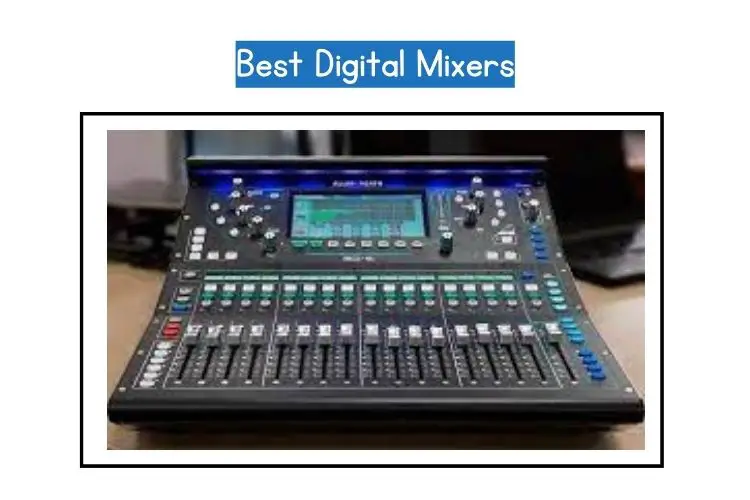

![Kaotica Eyeball vs Fatboy: ALL You Need to Know [2023]](https://performerlife.com/wp-content/uploads/2022/05/Kaotica-fatboy-211x150.jpg)

![What Happened To “Chief Keef”? [Everything to Know About This Rapper]](https://performerlife.com/wp-content/uploads/2022/05/Chief-Keef-211x150.jpg)